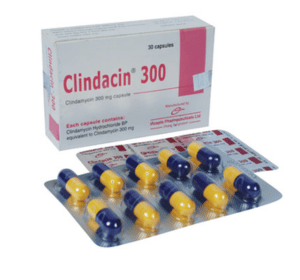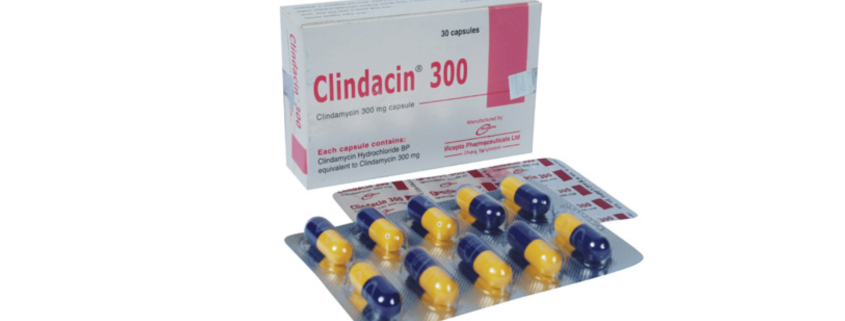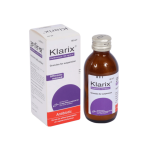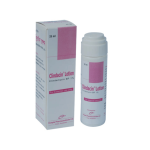Clindacin(Clindamycin)

Therapeutic Group: Anti Bacterial
Presentation
Clindacin 150 Capsule: Each capsule contains Clindamycin Hydrochloride BP equivalent to Clindamycin 150 mg.
Clindacin 300 Capsule: Each capsule contains Clindamycin Hydrochloride BP equivalent to Clindamycin 300 mg.
Clindacin Powder for oral solution: After reconstitution according to direction, each 5 ml solution contains Clindamycin Palmitate Hydrochloride USP equivalent to Clindamycin 75 mg.
Clindacin 300 IV/IM Injection: Each 2 ml Clindacin Sterile Solution contains Clindamycin Phosphate BP equivalent to Clindamycin 300 mg.
Clindacin 600 IV/IM Injection: Each 4 ml Clindacin Sterile Solution contains Clindamycin Phosphate BP equivalent to Clindamycin 600 mg
Description
Clindamycin is a lincosamide antibiotic used in the treatment of infections caused by susceptible microorganisms. Clindamycin is a semisynthetic antibiotic derived from lincomycin.
Microbiology
Aerobic gram-positive cocci, including: Staphylococcus aureus, Staphylococcus epidermidis (penicillinase and non-penicillinase producing strains), Streptococci, Pneumococci. Anaerobic gram-negative bacilli, including: Bacteroides species, Fusobacterium species. Anaerobic gram-positive non-spore forming bacilli, including: Propionibacterium species, Eubacterium species, Actinomyces species. Anaerobic and microaerophilic gram-positive cocci, including: Peptococcus species, Peptostreptococcus species, Microaerophilic streptococci, C. perferinges
Indications
Clindacin Capsule, Powder for oral solution and IV/IM Injection: Clindamycin hydrochloride has been shown to be effective in the treatment of the following infections when caused by susceptible anaerobic bacteria or susceptible strains of Gram-positive bacteria such as Streptococci, Staphylococci and Pneumococci; Upper respiratory infections, Lower respiratory infections, Skin and soft tissue infections, Bone and joint infections, Pelvic infections, Intra-abdominal infections, Septicemia and endocarditis, Dental infections. As an alternative therapy when used in combination with quinine or amodiaquine for the treatment of multi-drug resistant Plasmodium falciparum infection.
Dosage & Administration
Dosage of Clindacin Capsule
Serious Infections: 150 mg – 300 mg every six hours.
More severe infections: 300 mg – 450 mg every six hours.
To avoid the possibility of oesophageal irritation, Clindacin capsules should be taken with a full glass of water
Several researches have found that Clindamycin 300 mg capsule provides plasma concentration over MIC90 for more than 12 hours. These finding
supports the twice daily dosing of Clindacin 300 mg capsule particularly in SSTIs & RTIs.
However, incase of bone & joint infections, diabetic foot infections dose of Clindamycin should be 300 mg capsule 3-4 times daily.
Dosage of Clindacin Powder for oral solution
Serious infections: 8-12 mg/kg/day divided into 3 or 4 equal doses.
Severe infections: 13-16 mg/kg/day divided into 3 or 4 equal doses.
More severe infections: 17-25 mg/kg/day divided into 3 or 4 equal doses.
In pediatric patients weighing 10 kg or less, ½ teaspoon (37.5 mg) three times a day should be considered the minimum recommended dose.
Dosage of Clindacin IV/IM Injection
Adults
Parenteral (IV/IM Administration): Serious infections due to aerobic Gram-positive cocci and the more susceptible anaerobes:
600-1200 mg/day in 2- 4 equal doses.
More severe infections, 1200-2700 mg/day in 2-4 equal doses.
For more serious infections, these doses may have to be increased. In life-threatening situations due to either aerobes or anaerobes these doses may be increased. Doses of as much as 4800 mg daily have been
given intra-venously to adults.
Single intramuscular injections of greater than 600 mg are not recommended.
Neonates (less than 1 month)
15 to 20 mg/kg/day in 3 to 4 equal doses. The lower effective dosage may be adequate for small prematures.
Pediatric patients (1 month of age to 16 years)
Parenteral (IV/IM) administration: 20 to 40 mg/kg/day in 3 or 4 equal doses. The higher doses would be used for more severe infections.
Parenteral therapy may be changed to Capsules (clindamycin hydrochloride) when the condition warrants and at the discretion of the physician.
In cases of β-hemolytic streptococcal infections, treatment should be continued for at least 10 days.
DIRECTION FOR RECONSTITUTION (POWDER FOR ORAL SOLUTION)
Shake the bottle well to loosen the powder. Add 80 ml (with the help of supplied measuring cup) of boiled and cooled water to the dry mixture in the bottle. For ease of preparation, add water to the bottle in two
proportions. Shake well after each addition until all the powder is in solution. Keep the bottle tightly closed. The reconstituted solution should be used within 2 weeks if kept at room temperature
DILUTION OF CLINDACIN INJECTION FOR INTRAVENOUS USE
Dilution and Infusion Rates
Clindamycin phosphate must be diluted prior to IV administration. The concentration of clindamycin in diluent for infusion should not exceed 18 mg per ml. Infusion rates should not exceed 30 mg per minute. The
usual infusion dilutions and rates are as follows:
If Dose is 300 mg —Diluent (Dextrose 5% or NaCl 0.9%) is 50 ml—- Infusion Duration is 10 mins
If Dose is 600 mg —Diluent (Dextrose 5% or NaCl 0.9%) is 50 ml—- Infusion Duration is 20 mins
If Dose is 900 mg —Diluent (Dextrose 5% or NaCl 0.9%) is 50-100 ml—- Infusion Duration is 30 mins
If Dose is 1200 mg —Diluent (Dextrose 5% or NaCl 0.9%) is 100 ml—- Infusion Duration is 40 mins
*Administration of more than 1200 mg in a single 1 hour infusion is not recommended.
*Single IM injections of greater than 600 mg are not recommended. Dilution is not required for intramuscular administration.
*Parenteral drug products should be inspected visually for particulate matter and discoloration prior to administration, whenever solution and container permit
Dilution and Compatibility
Physical and biological compatibility studies monitored for 24 hours at room temperature have demonstrated no inactivation or incompatibility with the use of Clindamycin phosphate Sterile Solution (clindamycin
phosphate) in IV solutions containing sodium chloride, glucose, calcium or potassium, and solutions containing vitamin B complex in concentrations usually used clinically.
No incompatibility has been demonstrated with the antibiotics cephalothin, kanamycin, gentamicin, penicillin or carbenicillin.
Physico-Chemical Stability of diluted solutions of Clindacin Injection
Room temperature: 16 days at 25 degree C.
Refrigeration: 32 days at 4 degree C
Side Effects
The adverse effects have been reported with the use of clindamycin are- abdominal pain, oesophagitis and oesophagial ulcer, nausea, vomiting and diarrhoea, pruritus, skin rashes, urticaria.
Precautions
Clindacin should be prescribed with caution in individuals with a history of gastrointestinal disease, particularly colitis.
Use in Pregnancy & Lactation
Pregnancy
Pregnancy Category B: Clindamycin crosses the placenta in humans. After multiple doses, amniotic fluid concentrations were approximately 30% of maternal concentrations. Clindamycin should be used in
pregnancy only if clearly needed.
Lactation
Clindamycin has been reported to appear in breast milk. Therefore, it is not recommended for nursing mothers if not clearly needed.
Use in newborns and infants
When Clindamycin is administered to newborns and infants (birth to 16 years), appropriate monitoring of organ system functions is desirable.
Geriatric use
Dose adjustment of Clindamycin is not necessary.
Drug Interaction
Clindamycin enhance the action of other neuromuscular blocking agents. Therefore, it should be used with caution in patients receiving such agents. Antagonism has been demonstrated between clindamycin and erythromycin in vitro. Because of possible clinical significance, these two drugs should not be administered concurrently.
Over Dose
Overdosage with orally administered clindamycin has been rare. Adverse reactions similar to those seen with normal doses can be expected, however, unexpected reactions could occur. Haemodialysis and peritoneal dialysis are not effective in removing clindamycin from the serum. Overdosage should be treated with simple gastric lavage. No specific antidote is known.
Storage
Do not store above 30 °C. Keep away from light and out of the reach of children
Commercial Pack
Clindacin 150 Capsule: Each box contains 3 blister strips of 10 Capsules.
Clindacin 300 Capsule: Each box contains 3 blister strips of 10 Capsules.
Clindacin Powder for oral solution: Each bottle contains powder to be reconstituted into 100 ml oral solution.
Clindacin 300 IV/IM Injection: Each box contains 5 ampoules of 2 ml solution for injection.
Clindacin 600 IV/IM Injection: Each box contains 5 ampoules of 4 ml solution for injection



